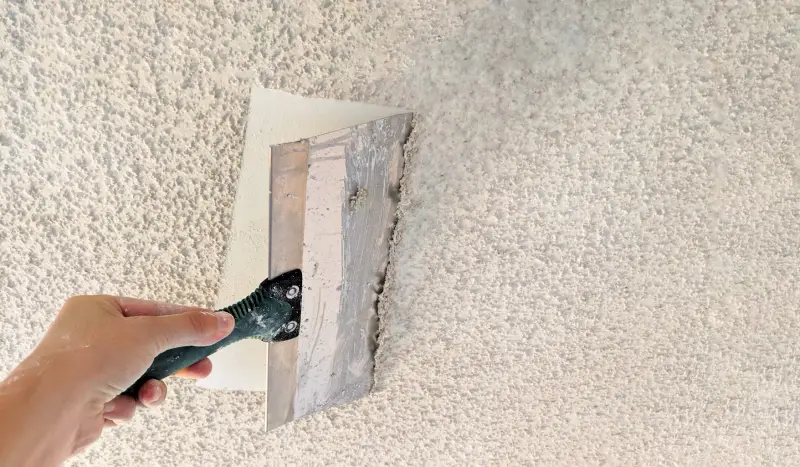Physical Address
304 North Cardinal St.
Dorchester Center, MA 02124
To clean basement walls, start by preparing a solution of water and mild detergent. Use a sponge or scrub brush to scrub the walls gently, then rinse with clean water.
Dry thoroughly with a towel or a fan. A clean basement not only enhances the aesthetics of your home but also promotes a healthier living environment. Over time, basement walls can accumulate dust, dirt, and other debris. Cleaning them regularly is essential to prevent mold growth and maintain the structural integrity of your basement.
We will provide you with a simple step-by-step guide to effectively clean your basement walls, ensuring that they remain in pristine condition. So, let’s get started and transform your basement into a cleaner and more inviting space.

Credit: www.fivestarpainting.com
Keeping your basement walls clean is crucial for a healthy home environment. Preventing mold and mildew growth and improving air quality are key reasons to maintain clean basement walls.
Moisture in basement walls can lead to mold and mildew growth, which can be detrimental to both your health and the structure of your home.
Clean basement walls contribute to cleaner air in your home, reducing the risk of respiratory issues and creating a healthier living space.

Credit: www.facebook.com
Preparation and Safety:
Before you begin cleaning your basement walls, it’s important to take the necessary steps to ensure your safety and the safety of those around you. This includes clearing the area, following safety precautions, and using the right equipment and materials. By adequately preparing and taking the necessary safety measures, you can efficiently clean your basement walls without any accidents or mishaps.
Before you start cleaning your basement walls, it’s essential to clear the area of any furniture, objects, or debris that may obstruct your cleaning process. By removing these items, you create a safe and unobstructed workspace, minimizing the risk of accidents or damage to your belongings.
When it comes to cleaning basement walls, safety should be your top priority. Here are some important safety precautions to keep in mind:
By following these safety precautions, you can minimize the risk of accidents and protect yourself while cleaning your basement walls. Safety should always be a priority, so don’t skip any steps to ensure a risk-free cleaning process.
Clean basement walls effectively with the right tools and materials. Use a sturdy scrub brush, mild detergent, warm water, and a bucket for the cleaning process.
When it comes to cleaning your basement walls, having the right tools and materials is essential. With the right resources at hand, you can effectively and efficiently tackle this task. This section will outline the must-have tools as well as the recommended cleaning solutions to get the job done.
To begin your basement walls cleaning project, you’ll need a few essential tools. Make sure you have these items ready before you start:
Now that you have the necessary tools, let’s move on to the cleaning solutions that are recommended for cleaning basement walls. These solutions are effective yet safe to use:
| Cleaning Solution | Recommended Usage |
|---|---|
| Vinegar and Water | A mixture of equal parts vinegar and water can be used for general cleaning purposes. It is effective in removing dirt and grime from the walls. |
| Bleach and Water | A diluted solution of bleach and water can be used to remove mold and mildew stains from the walls. Remember to wear protective gloves and ensure good ventilation when using bleach. |
| Commercial Wall Cleaner | If you prefer using a commercial product specifically designed for cleaning walls, choose one that is labeled safe for basements. Follow the manufacturer’s instructions for the best results. |
Remember to always test a small, inconspicuous area of your walls before using any cleaning solution to ensure it does not cause any damage. Additionally, follow proper safety precautions and ventilation guidelines when working with cleaning solutions.
To clean basement walls effectively, start by removing debris using a broom or vacuum. Then, mix a solution of warm water and mild detergent to scrub the walls using a brush. Rinse with clean water and allow to dry thoroughly.
A final step could be applying a waterproof sealer for long-lasting protection.
Start by clearing the area of any loose debris and dust to ensure a clean surface.
Prepare a cleaning solution of warm water and mild detergent for scrubbing the walls.
Welcome to the section where we tackle the most stubborn stains on your basement walls. Identifying these common stains and learning effective stain removal techniques will help you keep your basement walls clean and fresh.
Before delving into the cleaning process, it’s essential to identify the common stains you might find on your basement walls. Some of the most frequent offenders include:
Now that you’re familiar with the types of stains you may encounter, it’s time to explore some tried-and-tested stain removal techniques:
| Stain Type | Stain Removal Technique |
|---|---|
| Mold and Mildew | Use a mixture of water and white vinegar, or a commercial mold and mildew remover, to scrub the affected areas. Ensure proper ventilation and use protective gear when dealing with mold. |
| Water Stains | For minor water stains, a mixture of warm water and mild detergent can effectively remove the discoloration. For stubborn water stains, consider using a specialized stain remover for masonry surfaces. |
| Oil and Grease | Apply a generous amount of baking soda or cornstarch to the oil or grease stain to absorb the residue. After letting it sit for some time, use a brush or cloth to remove the powder, then clean the area with warm, soapy water. |
| Efflorescence | Scrub the affected area with a mixture of white vinegar and water, or use a commercial efflorescence cleaner to eliminate the chalky residue. Rinse the area thoroughly with clean water after cleaning. |

Credit: www.architecturaldigest.com
Basements are prone to moisture and mold growth, making it crucial to take preventive measures to keep the walls clean and in good condition. Implementing proper ventilation and waterproofing strategies are essential for maintaining a clean and healthy basement environment.
Ensure adequate ventilation in your basement to reduce the buildup of moisture and prevent mold and mildew growth. Install vents or exhaust fans to encourage air circulation and minimize humidity levels. Regularly open windows to let fresh air in and stale air out. Consider using a dehumidifier to control excess moisture in the air, especially in damp climates or during rainy seasons.
Invest in effective waterproofing methods to safeguard your basement walls from water infiltration. Seal any cracks or gaps in the walls to prevent water seepage. Apply a waterproofing coating to the exterior walls to create a protective barrier against moisture. Insulate pipes to prevent condensation and potential leaks. Maintain gutters and downspouts to ensure proper drainage away from the foundation, reducing the risk of water seeping into the basement.
Inspect your basement walls routinely to identify any signs of mold, dampness, or cracks.
Keep your basement walls clean to prevent the build-up of mold and mildew.
Ensure proper ventilation to reduce moisture levels in the basement, helping to maintain clean walls.
While cleaning basement walls can be a do-it-yourself project, there are instances where seeking professional assistance is necessary. Knowing when to call in the experts can save you time, effort, and ensure thorough results. Additionally, it is important to wrap up the cleaning process properly to maintain the cleanliness and longevity of your basement walls.
There are situations where professional help becomes a crucial step in cleaning basement walls. Consider the following scenarios:
After thoroughly cleaning your basement walls, it is crucial to properly wrap up the process. Follow these steps to ensure a successful conclusion:
By knowing when to seek professional assistance and properly wrapping up the cleaning process, you can ensure clean and well-maintained basement walls. Remember to prioritize regular cleaning and maintenance to keep your basement in optimal condition.
Cleaning basement walls is a crucial task for maintaining a healthy living space. By following the steps outlined in this guide, you can effectively remove mold, mildew, and dirt from your basement walls. Regular cleaning not only enhances the visual appeal of your basement but also ensures a safe and healthy environment for your family.